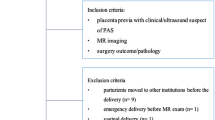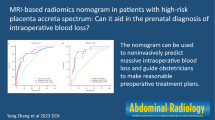Abstract
Objectives
To investigate whether an MRI–radiomics–clinical–based nomogram can be used to prenatal predict the placenta accreta spectrum (PAS) disorders.
Methods
The pelvic MR images and clinical data of 156 pregnant women with pathologic-proved PAS (PAS group) and 115 pregnant women with no PAS (non-PAS group) identified by clinical and prenatal ultrasonic examination were retrospectively collected from two centers. These pregnancies were divided into a training (n = 133), an independent validation (n = 57), and an external validation (n = 81) cohort. Radiomic features were extracted from images of transverse oblique T2-weighted imaging. A radiomics signature was constructed. A nomogram, composed of MRI morphological findings, radiomic features, and prenatal clinical characteristics, was developed. The discrimination and calibration of the nomogram were conducted to assess its performance.
Results
A radiomics signature, including three PAS–related features, was associated with the presence of PAS in the three cohorts (p < 0.001 to p = 0.001). An MRI–radiomics–clinical nomogram incorporating radiomics signature, two prenatal clinical features, and two MRI morphological findings was developed, yielding a higher area under the curve (AUC) than that of the MRI morphological-determined PAS in the training cohort (0.89 vs. 0.78; p < 0.001) and external validation cohort (0.87 vs. 0.75; p = 0.003), while a comparable AUC value in the validation cohort (0.91 vs. 0.81; p = 0.09). The calibration was good.
Conclusions
An MRI–radiomics–clinical nomogram had a robust performance in antenatal predicting the PAS in pregnancies.
Key Points
• An MRI–radiomics–clinical–based nomogram might serve as an adjunctive approach for the treatment decision-making in pregnancies suspicious of PAS.
• The radiomic score provides a mathematical formula that predicts the possibility of PAS by using the MRI data, and pregnant women with PAS had higher radiomic scores than those without PAS.




Similar content being viewed by others
Abbreviations
- AUC:
-
Area under the curve
- DICOM:
-
Digital imaging and communications in medicine
- ICC:
-
Intra- and inter-class correlation coefficients
- IDI:
-
Integrated discrimination improvement
- LASSO:
-
Least absolute shrinkage and selection operator
- MRI:
-
Magnetic resonance imaging
- NRI:
-
Net reclassification improvement
- PAS:
-
Placenta accreta spectrum
- ROC:
-
Receiver operating characteristic
- T1WI:
-
T1-weighted imaging
- T2WI:
-
T2-weighted imaging
- VIF:
-
Variance inflation factor
- VOI:
-
Volume of interest
References
Silver RM, Branch DW (2018) Placenta accreta spectrum. N Engl J Med 378:1529–1536
Cahill AG, Beigi R, Heine RP, Silver RM, Wax JR (2018) Placenta accreta spectrum. Am J Obstet Gynecol 219:B2–B16
Garmi G, Salim R (2012) Epidemiology, etiology, diagnosis, and management of placenta accreta. Obstet Gynecol Int 2012:873929
Dai M, Jin G, Lin J et al (2020) Control of postpartum hemorrhage in women with placenta accreta spectrum using prophylactic balloon occlusion combined with Pituitrin intra-arterial infusion. Eur Radiol 30:4524–4533
Jha P, Pōder L, Bourgioti C et al (2020) Society of Abdominal Radiology (SAR) and European Society of Urogenital Radiology (ESUR) joint consensus statement for MR imaging of placenta accreta spectrum disorders. Eur Radiol 30:2604–2615
Baughman WC, Corteville JE, Shah RR (2008) Placenta accreta: spectrum of US and MR imaging findings. Radiographics 28:1905–1916
Zaghal AA, Hussain HK, Berjawi GA (2019) MRI evaluation of the placenta from normal variants to abnormalities of implantation and malignancies. J Magn Reson Imaging 50:1702–1717
Mar WA, Berggruen S, Atueyi U et al (2015) Ultrasound imaging of placenta accreta with MR correlation. Ultrasound Q 31:23–33
Alamo L, Anaye A, Rey J et al (2013) Detection of suspected placental invasion by MRI: do the results depend on observer' experience? Eur J Radiol 82:e51–e57
Blaicher W, Brugger PC, Mittermayer C et al (2006) Magnetic resonance imaging of the normal placenta. Eur J Radiol 57:256–260
Siauve N (2019) How and why should the radiologist look at the placenta? Eur Radiol 29:6149–6151
Ren H, Mori N, Mugikura S et al (2021) Prediction of placenta accreta spectrum using texture analysis on coronal and sagittal T2-weighted imaging. Abdom Radiol (NY) 46:5344–5352
Lambin P, Leijenaar RTH, Deist TM et al (2017) Radiomics: the bridge between medical imaging and personalized medicine. Nat Rev Clin Oncol 14:749–762
Gillies RJ, Kinahan PE, Hricak H (2016) Radiomics: images are more than pictures, they are data. Radiology 278:563–577
Sun H, Qu H, Chen L et al (2019) Identification of suspicious invasive placentation based on clinical MRI data using textural features and automated machine learning. Eur Radiol 29:6152–6162
Chen E, Mar WA, Horowitz JM et al (2019) Texture analysis of placental MRI: can it aid in the prenatal diagnosis of placenta accreta spectrum? Abdom Radiol (NY) 44:3175–3184
Do QN, Lewis MA, Xi Y et al (2020) MRI of the placenta accreta spectrum (PAS) disorder: radiomics analysis correlates with surgical and pathological outcome. J Magn Reson Imaging 51:936–946
Wu Q, Yao K, Liu Z et al (2019) Radiomics analysis of placenta on T2WI facilitates prediction of postpartum hemorrhage: a multicentre study. EBioMedicine 50:355–365
Benirschke K, Burton GJ, Baergen RN (2012) Pathology of the human placenta, 6th edn. Springer-Verlag, Berlin
Lane BF, Vandermeer FQ, Oz RC, Irwin EW, McMillan AB, Wong-You-Cheong JJ (2011) Comparison of sagittal T2-weighted BLADE and fast spin-echo MRI of the female pelvis for motion artifact and lesion detection. AJR Am J Roentgenol 197:W307–W313
Zou KH, Warfield SK, Bharatha A et al (2004) Statistical validation of image segmentation quality based on a spatial overlap index. Acad Radiol 11:178–189
O’Brien RM (2007) A caution regarding rules of thumb for variance inflation factors. Qual Quant 41:673–690
Pencina MJ, D'Agostino RB Sr, D'Agostino RB Jr, Vasan RS (2008) Evaluating the added predictive ability of a new marker: from area under the ROC curve to reclassification and beyond. Stat Med 27:157–172
Romeo V, Ricciardi C, Cuocolo R et al (2019) Machine learning analysis of MRI-derived texture features to predict placenta accreta spectrum in patients with placenta previa. Magn Reson Imaging 64:71–76
Sosna J (2019) Fewer reproducible radiomic features mean better reproducibility within the same patient. Radiology 293:592–593
D'Antonio F, Iacovella C, Bhide A (2013) Prenatal identification of invasive placentation using ultrasound: systematic review and meta-analysis. Ultrasound Obstet Gynecol 42:509–517
D'Antonio F, Iacovella C, Palacios-Jaraquemada J, Bruno CH, Manzoli L, Bhide A (2014) Prenatal identification of invasive placentation using magnetic resonance imaging: systematic review and meta-analysis. Ultrasound Obstet Gynecol 44:8–16
Huang YQ, Liang CH, He L et al (2016) Development and validation of a radiomics nomogram for preoperative prediction of lymph node metastasis in colorectal cancer. J Clin Oncol 34:2157–2164
Morel O, van Beekhuizen HJ, Braun T et al (2021) Performance of antenatal imaging to predict placenta accreta spectrum degree of severity. Acta Obstet Gynecol Scand 100(Suppl 1):21–28
Kapoor H, Hanaoka M, Dawkins A, Khurana A (2021) Review of MRI imaging for placenta accreta spectrum: pathophysiologic insights, imaging signs, and recent developments. Placenta 104:31–39
Acknowledgements
We thank Wen Sun, M.D. (Department of Gynaecology and Obstetrics, The Third Affiliated Hospital of Guangzhou Medical University) and Qian Gao, M.D. (Department of Gynaecology and Obstetrics, The Third Affiliated Hospital of Sun Yat-Sen University) for their kind help with the clinical issue consultation.
Funding
This work was supported by the Natural Science Foundation of Guangdong Province (2021A1515010385) and the Medical Artificial Intelligence Project of Sun Yat-Sen Memorial Hospital (YXRGZN201905).
Author information
Authors and Affiliations
Corresponding authors
Ethics declarations
Guarantor
The scientific guarantor of this publication is Ting Song.
Conflict of interest
The authors of this manuscript declare no relationships with any companies whose products or services may be related to the subject matter of the article.
Statistics and biometry
No complex statistical methods were necessary for this paper.
Informed consent
Written informed consent was waived by the Institutional Review Board.
Ethical approval
Institutional Review Board approval was obtained from the Institutional Review Board of the Third Affiliated Hospital of Guangzhou Medical University (Guangzhou, China) (2022-006) and Sun Yat-Sen Memorial Hospital, Sun Yat-Sen University (Guangzhou, China) (SYSEC-KY-KS-2022-104).
Methodology
• retrospective
• diagnostic study
• two-center study
Additional information
Publisher’s note
Springer Nature remains neutral with regard to jurisdictional claims in published maps and institutional affiliations.
Supplementary Information
ESM 1
(DOCX 19 kb)
Rights and permissions
About this article
Cite this article
Peng, L., Zhang, X., Liu, J. et al. MRI–radiomics–clinical–based nomogram for prenatal prediction of the placenta accreta spectrum disorders. Eur Radiol 32, 7532–7543 (2022). https://doi.org/10.1007/s00330-022-08821-4
Received:
Revised:
Accepted:
Published:
Issue Date:
DOI: https://doi.org/10.1007/s00330-022-08821-4




